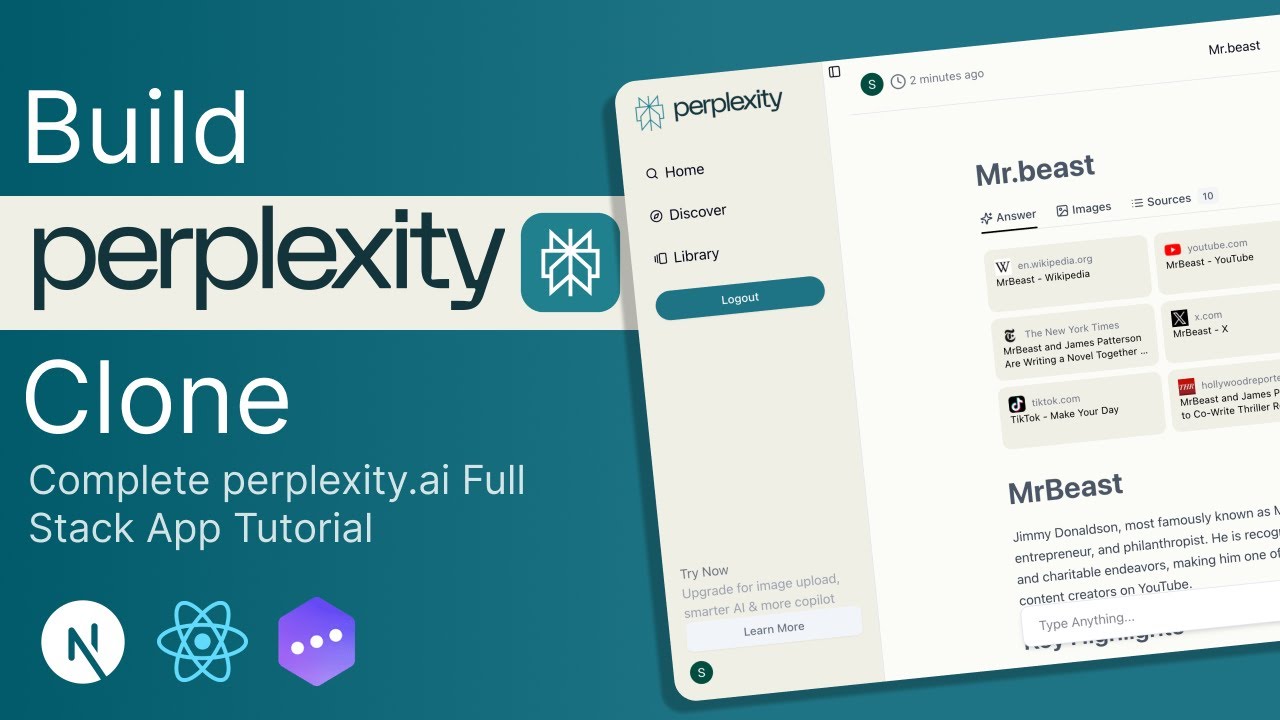Address
[wueseai_login_modal button_text="Sign In Now" button_class="px-6 py-3 bg-green-500 text-white rounded-full"]
Work Hours
Monday to Friday: 7AM - 7PM
Weekend: 10AM - 5PM
Address
[wueseai_login_modal button_text="Sign In Now" button_class="px-6 py-3 bg-green-500 text-white rounded-full"]
Work Hours
Monday to Friday: 7AM - 7PM
Weekend: 10AM - 5PM

This article guides you through building a Perplexity.ai clone using React and Next.js, creating a full-stack application from scratch. You’ll learn how Perplexity.ai gathers and presents real-time search information with sources, mirroring its unique approach. An accompanying video walks through the full process.
Replicate Perplexity.ai by building your own search application using React and Next.js. This project involves creating a full-stack application that fetches and summarizes real-time data from various sources. Learn to display information effectively, integrate different AI models, and deploy your application to the cloud for broader accessibility.
To start, you’ll need to set up a new Next.js application. Next.js is a React framework offering features like server-side rendering, static site generation, and API routes, making it ideal for building performant web applications.
Begin by navigating to the Next.js official website (nextjs.org) to access the documentation. The documentation provides comprehensive instructions for creating a new application and understanding Next.js’s core concepts.
Use the following command in your terminal to create a new Next.js application:
bash npx create-next-app@latest
This command initializes a new Next.js project with the latest version of the framework. Follow the prompts in the terminal to configure your project settings, such as the project name and whether to use TypeScript.
Perplexity.ai distinguishes itself from other AI models by providing real-time search information in a structured format, complete with citations. This approach ensures users receive up-to-date and verifiable information.
Key features of Perplexity.ai include:
When building your clone, focus on replicating these core functionalities to provide users with a similar experience.
The search functionality is the heart of your Perplexity.ai clone. This involves integrating with a search API to fetch relevant data based on user queries.
Steps to implement the search functionality:
Remember to handle API keys and sensitive information securely by using environment variables.
Displaying search results effectively, along with their sources, is crucial for building trust and providing context to the user.
Key considerations for displaying search results:
Use React components to create a modular and reusable structure for displaying search results.
To enhance the capabilities of your Perplexity.ai clone, consider integrating AI models for tasks like summarization, sentiment analysis, and language translation.
Ingest is a platform designed to simplify the creation of durable event-driven workflows, making it easier to manage complex AI integrations. It streamlines the process of integrating different AI models and ensures reliable API calls.
Benefits of using Ingest:
By using Ingest, you can focus on building the core features of your application without worrying about the complexities of managing AI model integrations.
To further enhance your Perplexity.ai clone, consider adding features like a library to save past searches and a discover section to showcase trending topics.
These features can significantly improve user engagement and provide additional value to your application.
Once you’ve built and tested your Perplexity.ai clone, it’s time to deploy it to the cloud so that others can access it.
Popular cloud platforms for deploying Next.js applications include:
Choose the platform that best suits your needs and follow their documentation to deploy your application.
Q: What is Next.js? A: Next.js is a React framework that enables features like server-side rendering and static site generation, making it ideal for building performant web applications.
Q: How can I integrate AI models into my application? A: You can integrate AI models using platforms like Ingest, which simplifies the management of API calls and event-driven workflows.
Q: What are the benefits of using Ingest? A: Ingest streamlines workflow management, ensures reliable API integrations, and enables developers to build AI-ready step functions more efficiently.
Q: How do I deploy my Next.js application to the cloud? A: You can deploy your Next.js application using platforms like Vercel, Netlify, or AWS Amplify, each offering seamless integration and automatic deployments.
By following this guide, you’ve gained a solid understanding of how to build a Perplexity.ai clone using React and Next.js. This project involves integrating real-time search capabilities, displaying data with clear source citations, and leveraging AI models for enhanced processing. Platforms like Ingest can further streamline the integration and management of AI functionalities, while cloud deployment services offer a seamless way to share your application with the world.
Credit: Creator
Credit: Writer
Credit: Reviewer